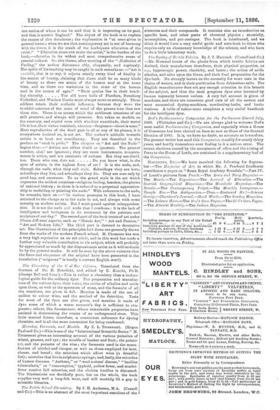The Education of the Artist. By Ernest Chesnean. Translated by
Clara Bell. " Fine Art Library." (Cassell and Co.)—" Throughout Europe art is in its decadence," is the opening statement of the book ; the only exception that is made is in favour of England,—" There is but one nation of whom it can be said that it is improving on its past, and that is artistic England." The object of the book is to explain the causes of this decadence ; the explanation is "at once given in general terms ; when we see that contemporary art is out of harmony with the times, it is the result of the inadequate education of the artist." "Education alone can make the artist," is the burden of the book,—education in its widest and most comprehensive sense of general culture. Oa this theme, after treating of the "/Esthetics of Feeling," the author discourses ably, eloquently, and copiously. The spirit of his teaching may be caught in such remarks as :—"Art is variable, that is to say, it rejects utterly every kind of finality in the matter of beauty, claiming that there shall be as many kinds e beauty as there are states of the human soul at the same time, and as there are variations in the state of the human soul in the course of ages." "Their genius lies in their touch-
ing sincerity The old town halls of Flanders, Strasburg Cathedral, and Windsor Castle must always move us strongly. These edifices retain their resthetie influence, because they were the truthful outcome of the state of mind of the genera'ions that saw them rise. There is an aroma which the sublimest creations of art still preserve, and always will preserve. But taken as models, on the contrary, and copied even with absolute exactitude, their moral life is lost, their virtue vanished ; emotion—fragrance—there is none." Mere reproduction of the dead past in all or any of its phases, it is everywhere insisted on, is not art. The author's attitude towards artists is at least not conciliatory. They are described in the preface as " sunk in pride." The chapter on " Art and the Nude " begins thus : —" Artists are either timid or ignorant. The greater number, alas ! are ignorant ; they are mere instruments, tempera- ments in action, and not creatures of culture. But they are timid, too. Those who can, dare not Do you know what, in the eyes of artists, is the highest form of art ? It is the nude, and, through the nude, what they call style. Schoolboys they are born, schoolboys they live, and schoolboys they die. They are men only by good hap, and unawares. To us the grand style is the art which expresses the noblest emotions—religious feeling, heroism, the glories of national history ; to them it is reduced to a perpetual apprentice- ship to modelling or painting the nude." With reference to the nude, he remarks, later on :—" In various passages in this book, I have returned to the charge as to the uncle in art, and always with some severity on modern artists. But I must guard against misapprehen- sion. It is not the nude quit nude that I condemn : it is the lack of intelligence and lovingness in its treatment by the painters and sculptors of our day." The second part of the book treats of art under fifteen different aspects, such as "Heroic Art," " Art and Passion," "Art and Modern Life." The third part is devoted to decorative art. The illustrations of the principles laid down are generally drawn from the works of the modern French school. M. Chesnean has won a very high reputation as an art critic, and in this work has made a further very valuable contribution to his subject, which will probably be appreciated as much by the dispassionate artist as it will no doubt be by the general reader. It will be seen by the above extracts that the force and eloquence of the original have been preserved in the translation (" exiguous " is hardly a current English word).



































 Previous page
Previous page